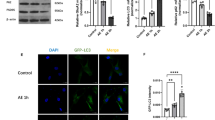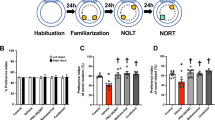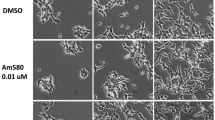Abstract
The over-expressions of brain-derived neurotrophic factor (BDNF) and its tyrosine kinase receptor TrkB have been reported to induce chemo-resistance in neuroblastoma (NB) cells. In this study, we investigated the roles of P53 and BCL2 family members in the protection of BDNF/TrkB from etoposide-induced NB cell death. TB3 and TB8, two tetracycline (TET)-regulated TrkB-expressing NB cell lines, were utilized. The expressions of P53 and BCL2 family members were detected by Western blot or RT-PCR. Transfection of siRNAs was used to knockdown P53 or PUMA. Activated lentiviral was used to over-express PUMA. Cell survival was performed by MTS assay, and the percentage of cell confluence was measured by IncuCyte ZOOM. Our results showed that etoposide treatment induced significant and time-dependent increase of P53, which could be blocked by pre-treatment with BDNF, and knockdown P53 by transfecting siRNA attenuated etoposide-induced TrkB-expressing NB cell death. PUMA was the most significantly changed BCL2 family member after treatment with etoposide, and pre-treatment with BDNF blocked the increased expression of PUMA. Transfection with siRNA inhibited etoposide-induced increased expression of PUMA, and attenuated etoposide-induced NB cell death. We also found that over-expression of PUMA by infection of activated lentiviral induced TrkB-expressing NB cell death in the absence of etoposide, and treatment of BDNF protected NB cells from PUMA-induced cell death. Our results suggested that P53 and PUMA may be potential targets that mediated the protection of BDNF/TrkB from etoposide-induced NB cell death.






Similar content being viewed by others
Abbreviations
- BDNF:
-
Brain-derived neurotrophic factor
- TrkB:
-
Tropomyosin-related kinase B
- NB:
-
Neuroblastoma
- MYCN:
-
Neuroblastoma MYC oncogene
- PI3K:
-
Phosphoinositied-3-kinase
- MAPK:
-
Mitogen-activated protein kinase
- HNSCC:
-
Head and neck squamous cell carcinoma
- TET:
-
Tetracycline
- FBS:
-
Fetal bovine serum
- DSBs:
-
DNA strand breaks
- Wip1:
-
Wild-type p53-inducible phosphatase 1
- DLBCL:
-
Diffuse large B-cell lymphoma
- TNBC:
-
Triple-negative breast cancer
- AML:
-
Acute myeloid leukemia
- NSCLC:
-
Non-small cell lung cancer
- FHIT:
-
Fragile histidine triad
References
Brodeur GM (2003) Neuroblastoma: biological insights into a clinical enigma. Nat Rev Cancer 3(3):203–216
Shohet J, Foster J (2017) Neuroblastoma. BMJ 357:j1863
Brodeur GM, Iyer R, Croucher JL, Zhuang T, Higashi M, Kolla V (2014) Therapeutic targets for neuroblastomas. Expert Opin Ther Targets 18(3):277–292. https://doi.org/10.1517/14728222.2014.867946
Vo KT, Matthay KK, Neuhaus J, London WB, Hero B, Ambros PF, Nakagawara A, Miniati D, Wheeler K, Pearson AD, Cohn SL, DuBois SG (2014) Clinical, biologic, and prognostic differences on the basis of primary tumor site in neuroblastoma: a report from the international neuroblastoma risk group project. J Clin Oncol 32(28):3169–3176
Brodeur GM, Bagatell R (2014) Mechanisms of neuroblastoma regression. Nat Rev Clin Oncol 11(12):704–713
Thiele CJ, Li Z, McKee AE (2009) On Trk—the TrkB signal transduction pathway is an increasingly important target in cancer biology. Clin Cancer Res 15(19):5962–5967
Li Z, Thiele CJ (2007) Targeting Akt to increase the sensitivity of neuroblastoma to chemotherapy: lessons learned from the brain-derived neurotrophic factor/TrkB signal transduction pathway. Expert Opin Ther Targets 11(12):1611–1621. https://doi.org/10.1517/14728222.11.12.1611
Jaboin J, Kim CJ, Kaplan DR, Thiele CJ (2002) Brain-derived neurotrophic factor activation of TrkB protects neuroblastoma cells from chemotherapy-induced apoptosis via phosphatidylinositol 3′-kinase pathway. Cancer Res 62(22):6756–6763
Ho R, Eggert A, Hishiki T, Minturn JE, Ikegaki N, Foster P, Camoratto AM, Evans AE, Brodeur GM (2002) Resistance to chemotherapy mediated by TrkB in neuroblastomas. Cancer Res 62(22):6462–6466
Kachalaki S, Ebrahimi M, Mohamed Khosroshahi L, Mohammadinejad S, Baradaran B (2016) Cancer chemoresistance; biochemical and molecular aspects: a brief overview. Eur J Pharm Sci 89:20–30
Jia L, Lu XA, Liu G, Wang S, Xu M, Tian Y, Zhang S, Fu Y, Luo Y (2017) Endostatin sensitizes p53-deficient non-small-cell lung cancer to genotoxic chemotherapy by targeting DNA-dependent protein kinase catalytic subunit. J Pathol 243(2):255–266. https://doi.org/10.1002/path.4952
Paek AL, Liu JC, Loewer A, Forrester WC, Lahav G (2016) Cell-to-cell variation in p53 dynamics leads to fractional killing. Cell 165(3):631–642
Cabelguenne A, Blons H, de Waziers I, Carnot F, Houllier AM, Soussi T, Brasnu D, Beaune P, Laccourreye O, Laurent-Puig P (2000) p53 alterations predict tumor response to neoadjuvant chemotherapy in head and neck squamous cell carcinoma: a prospective series. J Clin Oncol 18(7):1465–1473. https://doi.org/10.1200/JCO.2000.18.7.1465
Portt L, Norman G, Clapp C, Greenwood M, Greenwood MT (2011) Anti-apoptosis and cell survival: a review. Biochim Biophys Acta 1813(1):238–259
Hengartner MO (2000) The biochemistry of apoptosis. Nature 407(6805):770–776. https://doi.org/10.1038/35037710
Czabotar PE, Lessene G, Strasser A, Adams JM (2014) Control of apoptosis by the BCL-2 protein family: implications for physiology and therapy. Nat Rev Mol Cell Biol 15(1):49–63
Danial NN, Korsmeyer SJ (2004) Cell death: critical control points. Cell 116(2):205–219
Kaufmann SH, Vaux DL (2003) Alterations in the apoptotic machinery and their potential role in anticancer drug resistance. Oncogene 22(47):7414–7430
Radha G, Raghavan SC (2017) BCL2: a promising cancer therapeutic target. Biochim Biophys Acta 1868(1):309–314
Sartorius UA, Krammer PH (2002) Upregulation of Bcl-2 is involved in the mediation of chemotherapy resistance in human small cell lung cancer cell lines. Int J Cancer 97(5):584–592
Katkoori VR, Suarez-Cuervo C, Shanmugam C, Jhala NC, Callens T, Messiaen L, Posey J 3rd, Bumpers HL, Meleth S, Grizzle WE, Manne U (2010) Bax expression is a candidate prognostic and predictive marker of colorectal cancer. J Gastrointest Oncol 1(2):76–89
Chang HJ, Jung KH, Kim DY, Jeong SY, Choi HS, Kim YH, Sohn DK, Yoo BC, Lim SB, Kim DH, Ahn JB, Kim IJ, Kim JM, Yoon WH, Park JG (2005) Bax, a predictive marker for therapeutic response to preoperative chemoradiotherapy in patients with rectal carcinoma. Hum Pathol 36(4):364–371
Bender A, Opel D, Naumann I, Kappler R, Friedman L, von Schweinitz D, Debatin KM, Fulda S (2011) PI3K inhibitors prime neuroblastoma cells for chemotherapy by shifting the balance towards pro-apoptotic Bcl-2 proteins and enhanced mitochondrial apoptosis. Oncogene 30(4):494–503
Li Z, Zhang J, Liu Z, Woo CW, Thiele CJ (2007) Downregulation of Bim by brain-derived neurotrophic factor activation of TrkB protects neuroblastoma cells from paclitaxel but not etoposide or cisplatin-induced cell death. Cell Death Differ 14(2):318–326
Kastenhuber ER, Lowe SW (2017) Putting p53 in context. Cell 170(6):1062–1078
Jensen PB, Sehested M (1997) DNA topoisomerase II rescue by catalytic inhibitors: a new strategy to improve the antitumor selectivity of etoposide. Biochem Pharmacol 54(7):755–759
Hande KR (1998) Etoposide: four decades of development of a topoisomerase II inhibitor. Eur J Cancer 34(10):1514–1521
Zuckerman V, Wolyniec K, Sionov RV, Haupt S, Haupt Y (2009) Tumour suppression by p53: the importance of apoptosis and cellular senescence. J Pathol 219(1):3–15. https://doi.org/10.1002/path.2584
Sun B, Ross SM, Rowley S, Adeleye Y, Clewell RA (2017) Contribution of ATM and ATR kinase pathways to p53-mediated response in etoposide and methyl methanesulfonate induced DNA damage. Environ Mol Mutagen 58(2):72–83. https://doi.org/10.1002/em.22070
Slomnicki LP, Hallgren J, Vashishta A, Smith SC, Ellis SR, Hetman M (2016) Proapoptotic requirement of ribosomal protein L11 in ribosomal stress-challenged cortical neurons. Mol Neurobiol 55:538–553
Chen Z, Wang L, Yao D, Yang T, Cao WM, Dou J, Pang JC, Guan S, Zhang H, Yu Y, Zhao Y, Wang Y, Xu X, Shi Y, Patel R, Vasudevan SA, Liu S, Yang J, Nuchtern JG (2016) Wip1 inhibitor GSK2830371 inhibits neuroblastoma growth by inducing Chk2/p53-mediated apoptosis. Sci Rep 6:38011
Li L, Pongtornpipat P, Tiutan T, Kendrick SL, Park S, Persky DO, Rimsza LM, Puvvada SD, Schatz JH (2015) Synergistic induction of apoptosis in high-risk DLBCL by BCL2 inhibition with ABT-199 combined with pharmacologic loss of MCL1. Leukemia 29(8):1702–1712
Braso-Maristany F, Filosto S, Catchpole S, Marlow R, Quist J, Francesch-Domenech E, Plumb DA, Zakka L, Gazinska P, Liccardi G, Meier P, Gris-Oliver A, Cheang MC, Perdrix-Rosell A, Shafat M, Noel E, Patel N, McEachern K, Scaltriti M, Castel P, Noor F, Buus R, Mathew S, Watkins J, Serra V, Marra P, Grigoriadis A, Tutt AN (2016) PIM1 kinase regulates cell death, tumor growth and chemotherapy response in triple-negative breast cancer. Nat Med 22(11):1303–1313
Simpson LA, Burwell EA, Thompson KA, Shahnaz S, Chen AR, Loeb DM (2006) The antiapoptotic gene A1/BFL1 is a WT1 target gene that mediates granulocytic differentiation and resistance to chemotherapy. Blood 107(12):4695–4702
Wu DW, Lee MC, Hsu NY, Wu TC, Wu JY, Wang YC, Cheng YW, Chen CY, Lee H (2015) FHIT loss confers cisplatin resistance in lung cancer via the AKT/NF-kappaB/Slug-mediated PUMA reduction. Oncogene 34(19):2505–2515
Siddiqui WA, Ahad A, Ahsan H (2015) The mystery of BCL2 family: Bcl-2 proteins and apoptosis: an update. Arch Toxicol 89(3):289–317. https://doi.org/10.1007/s00204-014-1448-7
Hata AN, Engelman JA, Faber AC (2015) The BCL2 family: key mediators of the apoptotic response to targeted anticancer therapeutics. Cancer Discov 5(5):475–487
Acknowledgements
We thank the staff from Medical Research Center of Shengjing Hospital who gave us support throughout the experiments.
Funding
This work was supported by National Natural Science Foundation of China (Nos. 81472359, 81272538), Natural Science Foundation of Liaoning Province (No. 201602855), and 2013 Liaoning Climbing Scholar Foundation.
Author information
Authors and Affiliations
Contributions
ZH contributed to the study design, collection and interpretation of data, writing of the manuscript; YZ and SZ contributed to collection of data; YD, and MJ contributed to statistical analyses; FT, ZL, and CJT contributed to the interpretation of the data, and the writing of the manuscript; ZL contributed to the study design, interpretation of the data, the writing of the manuscript, and the submission of the manuscript for publication.
Corresponding author
Ethics declarations
Conflict of interest
The authors declare no conflict of interest.
Rights and permissions
About this article
Cite this article
Hua, Z., Zhan, Y., Zhang, S. et al. P53/PUMA are potential targets that mediate the protection of brain-derived neurotrophic factor (BDNF)/TrkB from etoposide-induced cell death in neuroblastoma (NB). Apoptosis 23, 408–419 (2018). https://doi.org/10.1007/s10495-018-1467-6
Published:
Issue Date:
DOI: https://doi.org/10.1007/s10495-018-1467-6




